Physiology > QUESTIONS & ANSWERS > Psych 111 Exam 2 chapter 7-10 Questions and answers solution docs latest update (All)
Psych 111 Exam 2 chapter 7-10 Questions and answers solution docs latest update
Document Content and Description Below
Psych 111 Exam 2 chapter 7-10 Questions and answers solution docs latest update CHAPTER 7: (56 Questions) Q: Sexual orientation is best defined as ____. Q: As part of his honor’s thesis, Bray... don develops a survey to evaluate the updated hierarchy of needs of Kenrick and colleagues, specifically in young adult men and women. Braydon is most interested in determining if men and women differ in the highest level of motivation, which is ____. Q: What two hormones are associated with romantic love? Q: Which scenario supports the Cannon-Bard theory of emotion? Q: Children who are highly responsive and show strong emotional reactions to novel stimuli are more likely to be ____ adults. Q: According to contemporary views of emotion, an emphasis on what factor may account for the vast range of emotional reactions that individuals have toward the same event? Q: Which model or theory proposes that emotions act as a reservoir that fills up and spills over, and that expressing these emotions will reduce arousal? Q: In a study of Japanese and American individuals (Matsumoto et al., 2002), how did the two cultures differ with regards to reading emotions? Q: What is the evidence to suggest that exposure to sex hormones in the womb affects sexual orientation? Q: When asked to identify what is most important to their happiness, an overwhelming majority of people typically rated ____ at the top of their list. Q: What evidence illustrates that the need for affiliation has a genetic component? Q: According to research (Cacioppo, Berntson, Norris, & Gollan, 2011), why do humans place a general priority on negative emotions over positive emotions? Q: The emotional quality of pain likely results from information processing at which level of the brain? Q: Sally loves to run, and works jogging into her daily schedule because of the “runner’s high” she experiences. Sally is motivated by a(n) ____ reward. Q: Drive theories of motivation are often described as “____” theories. Q: Gaia glances over at her roommate, who is on the phone with her mother. She watches as her roommate’s facial expressions change from happy – to sad – to angry – as she progresses through the phone conversation. What area of Gaia’s brain is most likely to change activity as she processes the different facial expressions? Q: Dr. Pollini is investigating how the brain regulates patterns of eating behavior. He performs an experiment and finds that lesioning a particular brain region causes rodents to significantly increase their food intake and to gain weight. What area of the brain has Dr. Pollini lesioned? Q: Why are men with older brothers, but not men with older sisters or those who are only children, more likely to be gay? Q: Patient S.M., who was unable to detect negative emotion in music and fear in images, suffered damage to which brain region? Q: Dr. Pasantes is investigating how the brain regulates patterns of eating behavior. She performs an experiment and finds that lesioning a particular brain region causes rodents to completely stop eating. What area of the brain has Dr. Pasantes lesioned? Q: In one study (Twenge, Baumeister, Tice, & Stucke, 2001), students who were told that a personality test revealed that they were “the type likely to end up alone later in life” were more likely to ____. Q: The Somatovisceral Afference Model of Emotion (SAME) provides a middle ground between which two theories of emotion? Q: Suppose that it is 1964, and that Betty, a homemaker who put on weight with each of her three pregnancies, wants to lose twenty pounds. What medication would have been prescribed to Betty at that time to help her lose weight? Q: Hours into their cross country road trip, Omar and Carl are famished. The two friends argue about what to do. Should they stop at a highway rest stop, or search for a place to eat in the nearest town? They decide to stop this time at a rest stop, and next time in town. How is motivation demonstrated in this scenario? Q: Interested in losing weight, Patrick seeks the advice of his doctor. Dr. Burns recommends a medication that can help Patrick by inhibiting the absorption of fats by the digestive tract. What medication is Patrick’s doctor recommending? Q: Which model or theory of emotion proposes that general arousal leads to assessment, which in turn leads to subjective feelings? Q: According to Maslow, what is at the pinnacle of human motivation? Q: A cultural norm that specifies when, where, and how a person should express an emotion is referred to as a ____. Q: According to a study (Matsumoto, Yoo, and Nakagawa, 2008), individuals from which nation are most likely to show emotion freely? Q: According to research (Kirk, Bailey, & Martin, 2000), if one identical male twin is homosexual, his twin has what percent chance of also being homosexual? Q: Selena has suffered from bulimia nervosa for several years. She finally seeks professional help and is surprised to find out that medication can help her. What type of medication would be most helpful for Selena? Q: Following a serious automobile accident several months ago, Lata is not able to read her bosses facial expressions to determine if he is happy or disappointed with her performance. Lata likely suffered damage to her ____. Q: We can think of motivation as a process that maintains ____. Q: According to research (van Anders, Hamilton, & Watson, 2007), who is likely to have the highest testosterone levels? Q: Individual differences in emotional intelligence are most predictive of ____. Q: Why are diabetics with high blood glucose levels likely to report feeling hungry? Q: According to the Somatovisceral Afference Model of Emotion (SAME), which scenario is likely to elicit the slowest emotional response? Q: Which brain region coordinates movements in response to emotional stimuli? Q: Following his afternoon classes, Darren stops at the cafeteria and eats a burger and fries. If you were to run a blood test on Darren shortly after his meal, what would you expect to find? Q: Why has our contemporary, sedentary lifestyle, with many people spending hours sitting in front of televisions or computers, contributed to a significant rise in obesity? Q: A state of tension and arousal triggered by cues important for survival is referred to as ____. Q: The binge-purge cycling of bulimia involves processes similar to those of ____. Q: Which researcher supports an incentive theory of motivation? Q: Molly is hungry. She passes right by the fruit basket on her kitchen counter and instead, grabs the ice cream out of the freezer. Molly’s behavior demonstrates what about human food preferences? Q: Of the following, who displays characteristics most consistent with high levels of achievement motivation? Q: Maslow’s view of motivation is best described as a ____. Q: The height-to-weight ratio used to identify healthy weight, underweight, overweight, and obesity is referred to as the ____. Q: Which model or theory of emotion proposes that there is a simultaneous and independent occurrence of physical sensations and subjective feelings during an emotional experience? Q: According to research (Stacher, 1986), what hormone contributes to feelings of satiety in response to the ingestion of food? Q: According to the Yerkes-Dodson law, ____ (Yerkes & Dodson, 1908). Q: What hormonal differences in women cause them to be more likely than men to equate sexual desire with feelings of romantic love? Q: Brianna suffers from anorexia nervosa. In addition to having an unusually low body weight, she has irregular menstrual cycles, feels cold constantly, and has skin that appears ____. Q: Which scenario supports the James-Lange theory of emotion? A: Micah wakes up feeling glum. He forces himself to smile from ear-to-ear and laugh out loud, and then he begins to feel happy. Q: Abnormal development of the amygdala is associated with which disorder? Q: Dr. Burke performs a neurological examination on his patient Ishmael. At one point he asks Ishmael to smile, but Ishmael produces only a crooked smirk. At the end of the examination, Ishmael tells Dr. Burke a humorous story, at which point Ishmael smiles ear-to-ear. Dr. Burke suspects that Ishmael suffered damage to his ____. Q: What was Walter Cannon’s hypothesis regarding hunger cues (Cannon & Washburn, 1912)? ________________________________________ CHAPTER 8: (62 Questions) Q: As Ronnie hears a song on the radio, she feels stressed: her heart races, her hands became clammy, and her breathing became rapid. The song is familiar because it was very popular at a time when her parents were going through a divorce. During this time, they fought bitterly with one another, causing Ronnie intense anxiety. In this scenario, identify the following in the same respective order: the conditioned stimulus, the unconditioned stimulus, the conditioned response, and the unconditioned response. Q: The learned ability to distinguish between stimuli is referred to as ____. Q: Learning that involves changes in the magnitude of responses to a specific stimulus is referred to as ____. Q: Keller and Marion Breland, two of B. F. Skinner’s former students who used operant conditioning to train animals for entertainment, encountered ____. Q: Thorndike’s Law of Effect states that behavior is ____. Q: The formation of associations between two stimuli, which occur sequentially in time, is referred to as ____. Q: Which process gives organisms the flexibility to survive in a changing world? Q: Which of the following is an example of nonassociative learning? Q: Peter’s father normally arrives home from work in a terrible mood, causing Peter extreme anxiety. However, when Peter sees that his father is wearing sweat pants, Peter feels at ease, knowing that his father has been home from work for awhile. Peter’s distinct responses towards his father illustrates ____. Q: Lucia, who experiences extreme anxiety when taking an exam, practices meditation breathing to reduce her anxiety prior to taking a test. Her meditation breathing is an example of a ____. Q: Based on a patient’s prior experience with medicine, which mode of learning is likely responsible for the efficacy of the placebo effect? A: classical conditioning Q: Based on the work of Richard Dawkins, the basic unit of cultural transmission is known as a(n) ____. Q: As a gate creaks open, Oscar the puppy notices a cat heading into his yard. The cat hisses and scratches Oscar on the nose, causing Oscar to yelp in pain. Which outcome to this scenario portrays higher order conditioning? Q: A reinforcer that gains value from being associated with other things that are valued is called a(n) ____. Q: Mirror neurons play a key role in which of the following processes? Q: Which of the following is an example of a fixed ratio schedule? A: Sam earns extra money by mowing his neighbors’ lawns in the summer and shoveling their driveways and sidewalks in the winter. He charges $20 per job. Q: In Garcia and Koelling’s taste aversion study, why were the rats unable to associate a bright-noisy stimulus with feeling ill? Q: Marcus, who runs a software development company, repeatedly thanks his administrative assistant, Shana, for her hard work. Lately however, Marcus neglects to acknowledge the accomplishments of Shana; leading to her dwindling performance. What likely contributed to Shana’s performance problems? Q: Dr. Graham exposes rats to a vanilla scent prior to receiving a food pellet in the left corner of their cage, but provides no food after exposure to a lemon scent. After several trials, upon smelling a vanilla scent, the rats wait at the far left corner of the cage regardless of whether a food pellet is present. However, they do not wait in the far left corner when exposed to the lemon scent. What is the unconditioned stimulus in the experiment? Q: Research suggests that children over-imitate adults ____. Q: Learning is traditionally divided into three categories: associative, nonassociative, and ____. Q: Brian watches the Boston Celtics games on TV. According to Bandura, what would motivate Brian to try to imitate the Boston Celtics? Q: Which of the following approaches does B.F. Skinner recommend to alter an undesirable behavior? Q: Which of the following is likely to provide the most powerful method for managing behavior? Q: Eduardo, a psychologist, uses systematic desensitization to help his client, Catherine, address her extreme fear of heights. What technique is Eduardo likely to use? Q: Tim would like to stop drinking alcohol, but he is finding it difficult to resist the urge to drink when he meets up with friends. Tim’s therapist assures him that if he can resist the urge to drink during these social events, his cravings for alcohol will diminish even further, eventually fading away. What process is Tim’s therapist describing? Q: The tendency to respond to stimuli that are similar to an original conditioned stimulus is called ____. Q: What type of partial reinforcement depends on the number of times a behavior occurs? Q: If people are continuously startled by a stimulus that they know will not cause them harm, they will fail to ____. Q: What is true of operant conditioning? Q: In which of the following scenarios is Roxie the dog most likely to rapidly learn to associate a conditioned stimulus with food? Q: An environmental cue or event whose significance is learned through classical conditioning is referred to as a(n) ____. Q: Bandura identified four necessary cognitive processes in the modeling of others’ behavior: ____. Q: Which of the following would decrease the likelihood of acquisition? Q: Which of the following methods of behavior modification adheres to the Premack Principle? Q: The Brelands concluded that animals’ strong instinctive behaviors predominated over behaviors that had been conditioned, which they described as ____. Q: Which of the following is an example of a variable interval schedule? Q: What type of stimulus elicits a response without prior experience? Q: Based on the findings of Garcia and Koelling, which type of stimuli would be most effective for training birds? Q: What is a disadvantage of continuous reinforcement? Q: Mrs. Collora teaches social studies to junior high school students. Two boys in her class often loudly make jokes about the material being discussed. She has tried several techniques without success: 1) ignoring them; 2) encouraging and rewarding them for contributing to the class discussion; 3) removing their opportunities to participate in field trips; and 4) sending them to detention. In the order presented, list the operant conditioning principles she has applied to the situation. Q: When Roxie the dog was a puppy, she would jump excitedly on anyone who entered the house; receiving praise for her actions. Now that Roxie weighs 65 pounds, Roxie’s owner has asked everyone who enters the house to ignore the dog until she settles down. This scenario illustrates the use of ____. Q: Richard, who is sixteen years old, misses his curfew and as a result is grounded by his parents. His parent’s actions illustrate ____. Q: Greg, who mainly smoked cigarettes when out with friends, recently quit smoking. However, each time he visits a bar or restaurant with his friends, he has the strong urge to light up a cigarette. This is an example of ____. Q: How can extinction be avoided with operant conditioning? Q: Which process explains why children exposed to news reports about crime tend to form stronger associations between criminal acts and people of unfamiliar races rather than between criminal acts and people of their own race? Q: What delays the process of extinction? Q: The rats involved in Skinner’s research boxes learned to press levers for food through the process of ____. Q: Who is likely to discontinue his or her behavior first if reinforcement completely stops? Q: Learning that occurs in the absence of reinforcement is referred to as ____. Q: As Angel speeds down Elm Avenue, he suddenly slams on his brakes to avoid a collision with another car. Angel’s response is an example of a(n) ____. Q: When he was nine years old, Mike tried shrimp for the first time; but felt ill shortly after. To this day, he cannot bring himself to eat shrimp. This is an example of ____. Q: Experienced whale trainer Dawn Brancheau was killed by one of her favorite killer whales during a 2010 show at Sea World in Orlando, Florida. Animal experts believed that the whale had simply reverted to normal whale behavior; illustrating ____. Q: What is true of latent inhibition? Q: Compared with classical conditioning, the role of the learner for operant conditioning is ____. Q: What mechanism is responsible for the process of extinction? Q: A schedule of reinforcement in which the first response after a varying period of time is reinforced is called a(n) ____. Q: Kate’s six-year-old son has autism. To help him learn daily tasks, she breaks down activities into their component parts. Tooth brushing, for example, involves several steps that occur in basically the same order each time. Which of the following learning principles would provide the strongest foundation for learning how to brush one’s teeth in this context? Q: How does the presence of other people alter performance? Q: Based on his experiments with rats in mazes, Edward Tolman believed that ____. Q: Following a devastating fire that destroyed her home, Lisbeth finds that she is startled by the sound of car horns and sirens, the smell of smoke, and loud noises. This is an example of ____. ________________________________________ CHAPTER 9: Q: Jean has an intense fear of bears, including large teddy bears, and often discusses the topic. She thinks that a bear attacked her in the family’s living room when she was young, and that there was a party going on at the same time. Her mother recently found a video of her daughter’s fourth birthday party in which her uncle held his gift, a large teddy bear, in front of his face and growled ferociously. This indicates that Jean’s memory of the bear attack is likely ____. Q: Jeremy is typing a term paper on his computer and saves it every five minutes or so for good measure. Which of the following best illustrates the computer’s encoding system with regard to this file? Q: Allan and Bob are debating the true meaning of the term memory. How does your textbook define this process? Q: Stephen has just finished composing his first poem, entitled Clouded Memories, for his poetry slam class. He is slated to recite the first ten lines during class tonight, and repeats them over and over to himself as he is walking there. This is called ____. Q: Kevin is legally required to send a quarterly check to his former wife, whom he divorced twenty years ago. It annoys him greatly and he finds he often forgets until several days after the due date. This is likely an example of ____. Q: Which of the following techniques would be most helpful to Hannah while studying for her Gender and Society exam? Q: Michael has a flashbulb memory of when his mother told him the terrible news that his father had died in an automobile accident. What is most likely to be true about this memory? Q: Which of the following is a declarative memory? Q: Extremes in memory retrieval, such as the complete failure to recall an emotional event or an intrusive, overly vivid amount of recall, start to occur when an event ____. Q: Long-term potentiation shares many features with memory, such as being ____. Q: Out of all cases in which an innocent person has been cleared of a crime due to DNA evidence, how many involved mistaken identification of the perpetrator by an eyewitness? Q: A graph of the serial position effect, where the likelihood of recall of an item is plotted as a function of the item’s position in a list during presentation, takes the shape of a(n) ____. Q: Brian cannot remember whether he told his parents that he would be bringing his three roommates over for dinner on Sunday, or if he had just reminded himself to tell them. Which of the following statements best describes processing in this type of scenario? Q: What is the correct ordering of the processes of memory? A: encoding, storage, and retrieval Q: The four components of working memory proposed by Baddeley et al. are called the central executive, the episodic buffer, the visuospatial sketch pad, and the ____. Q: Tom often smokes while studying in his apartment. Of course, he cannot smoke during his exams. This may make retrieval of the material more difficult because of ____. Q: In her research, Brenda Milner found that Molaison could learn a new procedural task, mirror tracing, as well as typical control participants did. However, he could not remember the details of the task. This outcome suggests that ____. Q: Marcus, a psychology major, is participating in his professor’s research study. The study requires Marcus to repeat back word lists, which, in his short-term memory, are translated into ____. Q: In Zyzak, Otto, Eichenbaum, & Gallagher (1995), elderly rats that performed well in a maze had higher levels of ____ synthesis than their less capable peers. Q: Anita and Bev decide to verbally exchange e-mail addresses before running off to their next class so that they can get in touch with each other via computer. They will likely be able to retain this information in sensory memory for ____. Q: The NMDA receptor, a prime candidate for learning-related changes such as those observed in long-term potentiation, is a type of ____. Q: "Decay" is defined as: Q: Study participants who listen to rude words are more likely to interrupt someone else than participants who listen to polite words. This effect is best described by which term? Q: Long-term memory is characterized by ____. Q: Sarah is having a tip-of-the tongue experience with the name of an Indian restaurant that recently received a great review. She suspects that it may start with a K and consist of two syllables, but all that comes to mind is Canton or Colorado. Which of the following choices would be the most likely name of the restaurant? Q: In research which studies the retention of information in long-term memory, the "method of savings" refers to: Q: An implicit memory is also known as a(n) ____. Q: The spreading activation model accounts for the results of the lexical decision experiments that demonstrate priming by explaining ____. Q: Which of the following is one of the most important schemas we have for organizing and remembering what we study? Q: Compared to control participants, London cab drivers had larger volume in which brain area? Q: Ella is a participant in a study using the lexical decision task technique. To which pair of real or non-real words would she likely have the fastest response time? Q: What is reconstruction? Q: Jerome’s prefrontal cortex was damaged as a result of a skiing accident. He retained his semantic and procedural knowledge of how to drive a standard shift automobile. Jerome would most likely have problems recalling which of the following? Q: The effect of negative emotions on memory ____. Q: Mary is visiting the beach close to her childhood home. Which of the following best describes her memories of childhood summers? Q: In most cases, information moves from short-term or working memory to long-term memory through ____. Q: When Frederic Bartlett’s study participants recalled the story he had read to them twenty hours earlier, they ____. Q: Ron is about to leave his apartment. His keys are not where he usually tries to leaves them – on his bureau. He starts to retrace his steps from the night before and realizes that he should look in the bathroom, as this was his first stop upon arrival. This reflects the process of ____. Q: Which of the following is NOT true of autobiographical memories? Q: A flashbulb memory is ____. Q: Paolo is studying for his doctoral qualifying exams in neuropsychology. According to fuzzy trace theory, what would be the best way to study for these exams? Q: Declarative memories are consciously retrieved memories that are easy to verbalize and include ____. Q: Your text discusses recovered memories of childhood abuse. In the absence of proof, the authors recommend ____. Q: The effect of our motivations on our retrieval of memories ____. Q: Both brains and computers have the ability to store memories, with one critical difference. What is this difference? Q: Jake, a 24-year-old Caucasian man, was caught in a stolen car and taken into the police station for identification. Which of the following lineups would be the fairest for Jake? Q: The second stage of the Atkinson-Shiffrin model holds a small amount of information for a limited time. This is called ____. Q: Fred drives a delivery truck in a large metropolitan area. He enjoys the challenge of finding new routes and short cuts to his destinations. This spatial activity uses his ____. Q: The type of declarative memory problems experienced by Henry Molaison are frequently produced by damage to the ____. Q: According to the Atkinson and Shiffrin model of memory, information flows through three stages. What illustrates the correct flow of information in this model? Q: Doris is memorizing some chapter definitions for an economics quiz. For each defined term, she repeats the definition and uses the term in a sentence. She is engaging in ____. Q: What is an adaptation of the idea of "short-term memory" that also includes the active manipulation of multiple types of information simultaneously? Q: Marietta has memorized the capital cities of all fifty states. This is an example of ____. Q: Which of the following statements regarding semantic memories is true? Q: Under the spreading activation model, which of the following concepts or properties would have the weakest connection with the word “rose” for most people? Q: In a study by Loftus and Palmer, participants viewed a short video of an automobile accident. One group was asked “About how fast were the cars going when they hit each other?” A second group was asked “About how fast were the cars going when they smashed each other?” One week later, both groups were asked if they recalled seeing glass on the road after the accident (there was no glass on the road in the video). Which of the following statements is true? Q: Chunking is the ____. Q: What is the basis for the effectiveness of the method of loci? Q: The spreading activation model proposes that people organize general knowledge based on ____. Q: The first stage of the Atkinson-Shiffrin model involved the retention of large amounts of incoming data for very brief amounts of time. This is called ____. Q: In one of Elizabeth Loftus’s research experiments, she superimposed real family photos of her study participants onto a picture of a hot air balloon. What was the result? Q: When Gina was ten, she swam in the ocean for the first time. She remembers the feeling of kicking her feet, slicing her arms through the water, tasting the tangy salt water, floating her on her back, and learning from her father that salt water is more dense than fresh water, which makes floating easier. Which element is a semantic memory? Q: A conscious memory, also known as a declarative memory, is called a(n) ____. Q: Alex is starting his day. Which of the following represents a procedural memory? Q: Tom was knocked unconscious briefly during a game while playing on his high school’s football team. He does not remember much about the immediate circumstances leading to the injury. Why? ________________________________________ CHAPTER 10: Q: Which of the following is true about dyslexia? Q: What are the four steps of problem solving? Q: Chimpanzees, bonobos, and gorillas have a part of the brain that is ____. Q: Angela has a dream of devoting her career to the reduction, or possible worldwide elimination, of malaria. What does the text recommend as an approach to address a substantial, long-term problem such as malaria? Q: Which of the following is true regarding the relationship between “genius” and IQ? Q: Leena’s and Ruth’s mother takes them to see a dermatologist for their acne. The dermatologist, Dr. Pore, sees each daughter separately but prescribes the same medication for both. Dr. Pore tells Leena the medication has a 75% effectiveness rate. She tells Ruth the medication has a 25% failure rate. Leena leaves the appointment more optimistic than Ruth. This is an example of ____. Q: The most critical element for Marie to successfully implement her solution is to ____. Q: The American Academy of Pediatrics advises parents that children under the age of two should have zero screen time (television or computers). What is the current trend with regard to children, parenting, and the media? Q: The field of neuroeconomics is particularly interested in ____. Q: Which of the following is the best example of an adaptive behavior? Q: American Sign Language is ____. Q: Which group is most likely to use visual images in their thought processes? Q: A person with moderate intellectual disability ____. Q: What is the most important element when generating possible solutions to a problem? Q: Based on the longitudinal study of gifted children initiated in 1921, which of the following was found to be true through their adulthood? Q: Broadly speaking, knowledge is the entire body of information acquired through study, investigation, observation, and experience. To manage all of this knowledge, the mind often uses ____. Q: Measures of brain activity during tasks requiring intelligence indicate that, in order to solve the same problem, the brains of people with high scores on standard intelligence measures ____. Q: Researchers have attempted to teach human languages to apes and African gray parrots, among others. What was one result of these interactions, based on the cases described in your text? Q: What is a rule of thumb approach in which we choose between alternatives based on emotional or “gut” reactions to stimuli? Q: An organizing principle derived from experience is a(n) ____. Q: Which of the following pairs expresses an arguably correct relationship with regard to language learning? Q: According to Benjamin Lee Whorf’s hypothesis of linguistic relativity, what affects a person’s ability to think about a topic? Q: The heritability of adult intelligence as measured by IQ tests is usually reported to be about .75, which means that ____. Q: Marie’s roommate suggests that she use a Gantt chart in preparation for the race. This is because the Gantt chart will ____. Q: Who is most likely to be enjoying a lifetime peak in both fluid and crystallized intelligence? Q: Selena’s parents arrange for her to take part in an intelligence test for preschool admissions. Her individual intelligence is measured to be 125 relative to a statistically normal curve with an average of 100. This is her ____. Q: Betty has been a saver all of her life, but recently, she became a gambler. She is considering betting all of her savings in a lottery in hopes of making enough money for an around-the-world cruise. Betty may have suffered damage to her ____. Q: Which of the following is true? Q: In which of the following ways does a typical child first learn language? A: Evan seems to learn words and form small sentences effortlessly with no specific instruction. Q: Shirley’s home is full of piles of old newspapers and magazines. She feels she might find the information in these useful someday. She also collects rags, old paper towels, plastic bags, and empty bottles and cans. Shirley likely has ____. Q: Dolores, a college freshman, has moved to a big city for the first time in her life. She is excited by the opportunity to explore the city, but is also anxious about what she read recently about street crime in one of the city’s neighborhoods. In reality, she is more at risk of harm from reckless drivers. What heuristic is she applying is this situation? Q: After reading a bit about this issue, Marie believes that the gain is primarily due to engaging in less physical activity than in her high school years, rather than a change in her eating habits. This is an example of ____. Q: Older adults who were bilingual seemed to experience a delayed onset of symptoms of Alzheimer’s disease compared to monolingual older adults, possibly due to ____. Q: Place the following conditions in order from the least difficulty to the most difficulty in terms of the ability to learn language. Q: Regor has learned quite a bit about sailboats and is now excited about experiencing life on the water. So, Marvin and his dad take Regor sailing one weekend. Regor now has a set of beliefs, expectations, and personal experiences related to sailboats and sailing to which he can add new information. This is called a ____. Q: Children with average IQ scores showed a peak thickening of cortical gray matter around the age of 8, while children with superior IQ scores experienced a peak thickening at around ____. Q: Rajon is trying to decide between majoring in psychology and majoring in economics. He considers the intensity of each major since he will be on the varsity football team next year, his interest in the subject matter of the required courses in each field, and the likelihood of finding a job after graduation. He has employed ____. Q: Which of the following is true of mental images? Q: Which of the following is the most effective method to support a child’s language learning? A: Engaging in two-way interaction in the form of conversation Q: Giftedness is an extreme of intelligence defined as having an IQ score of ____. Q: Which of the following is true regarding theories of general intelligence and multiple intelligences? Q: Which of the following is true about algorithms? Q: A measure of an individual’s overall intelligence as opposed to specific abilities is called ____. Q: Marvin suggests that Regor compare the features of an item that he thinks might be a sailboat with a checklist of sailboat features. If there are sufficient overlapping features, he might determine that it is a sailboat. This could be considered a ____. Q: Damage to the orbitofrontal cortex, such as that suffered by Phineas Gage, reliably produces ____. Q: Marvin tries to describe the common features of a sailboat. He explains that they are pointed at the front and square at the back, have a tall mast to hold up the sail, and have one or two triangular sails. Which of the following demonstrates a problem with this approach? Q: Marie feels that she has never been athletic and therefore, could not possibly run in a charity race with her friends in the spring, though she would like to become more physically active to address her weight gain. This reflects ____. Q: One approach to language suggests that it results from some innate capacity shaped by natural selection, which implies that we might be able to find precursors of human language in the behavior of other animals. This is called the ____. Q: Standard measures of intelligence are positively correlated with ____. Q: Understanding a problem should ____. Q: Marie is determined to make a plan to address her weight gain problem. First, she must generate possible solutions. What should she do next? Q: Behaviorists, including B. F. Skinner, argued that children learn language through ____. Q: A healthy orbitofrontal cortex helps us think about ____. Q: Which of the following is a phoneme? Q: Max, an attorney, is attending a hearing at the federal courthouse. He opens the courthouse door for a young woman with a tattoo on her forearm. When Max enters the room of the hearing, he is stunned to see that the assigned judge is the same woman. Max had applied the ____. Q: Marvin shares as many details as he can remember about the small sailboat he had as a child. This is called a(n) ____. [Show More]
Last updated: 1 year ago
Preview 1 out of 23 pages

Buy this document to get the full access instantly
Instant Download Access after purchase
Add to cartInstant download
We Accept:

Reviews( 0 )
$6.50
Document information
Connected school, study & course
About the document
Uploaded On
Nov 12, 2020
Number of pages
23
Written in
Additional information
This document has been written for:
Uploaded
Nov 12, 2020
Downloads
0
Views
215




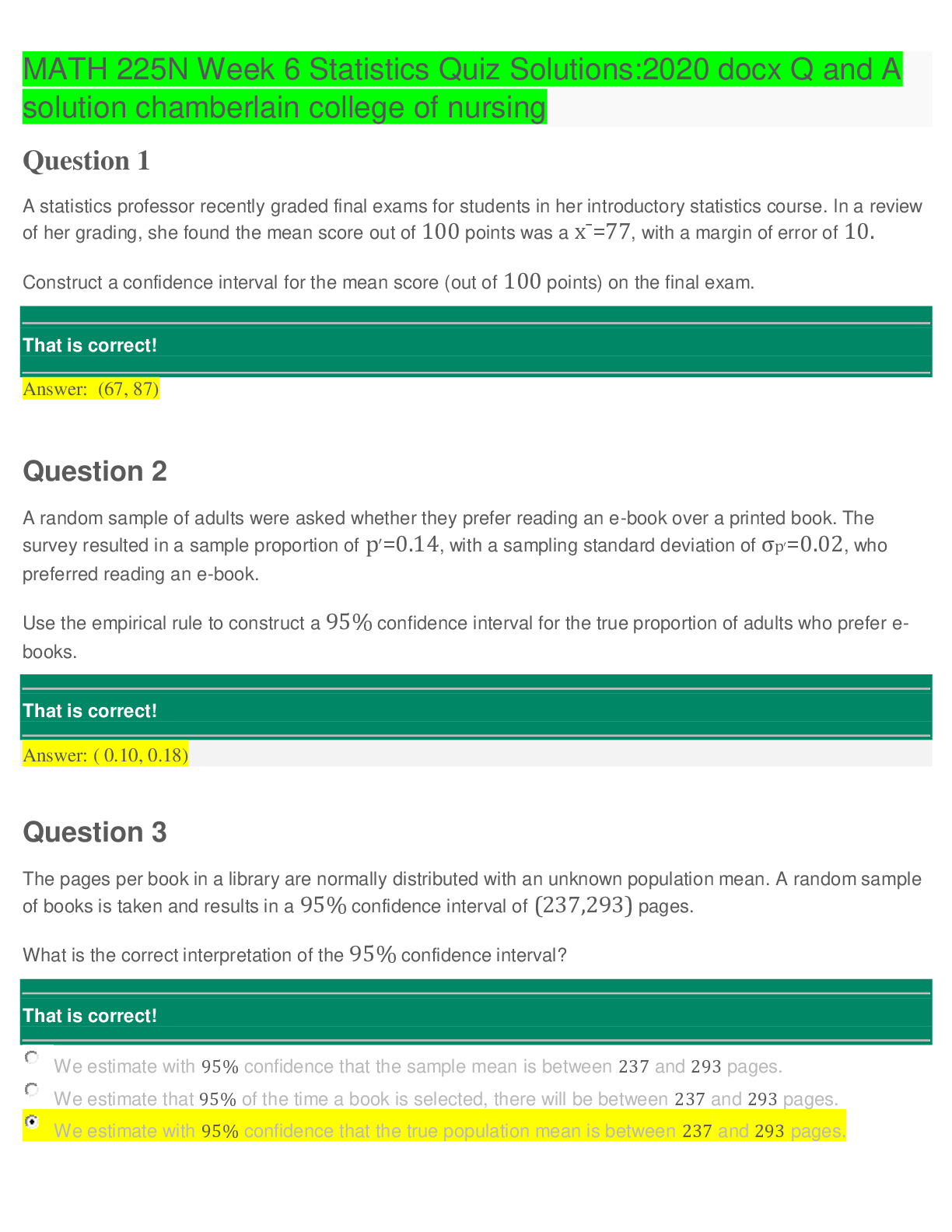

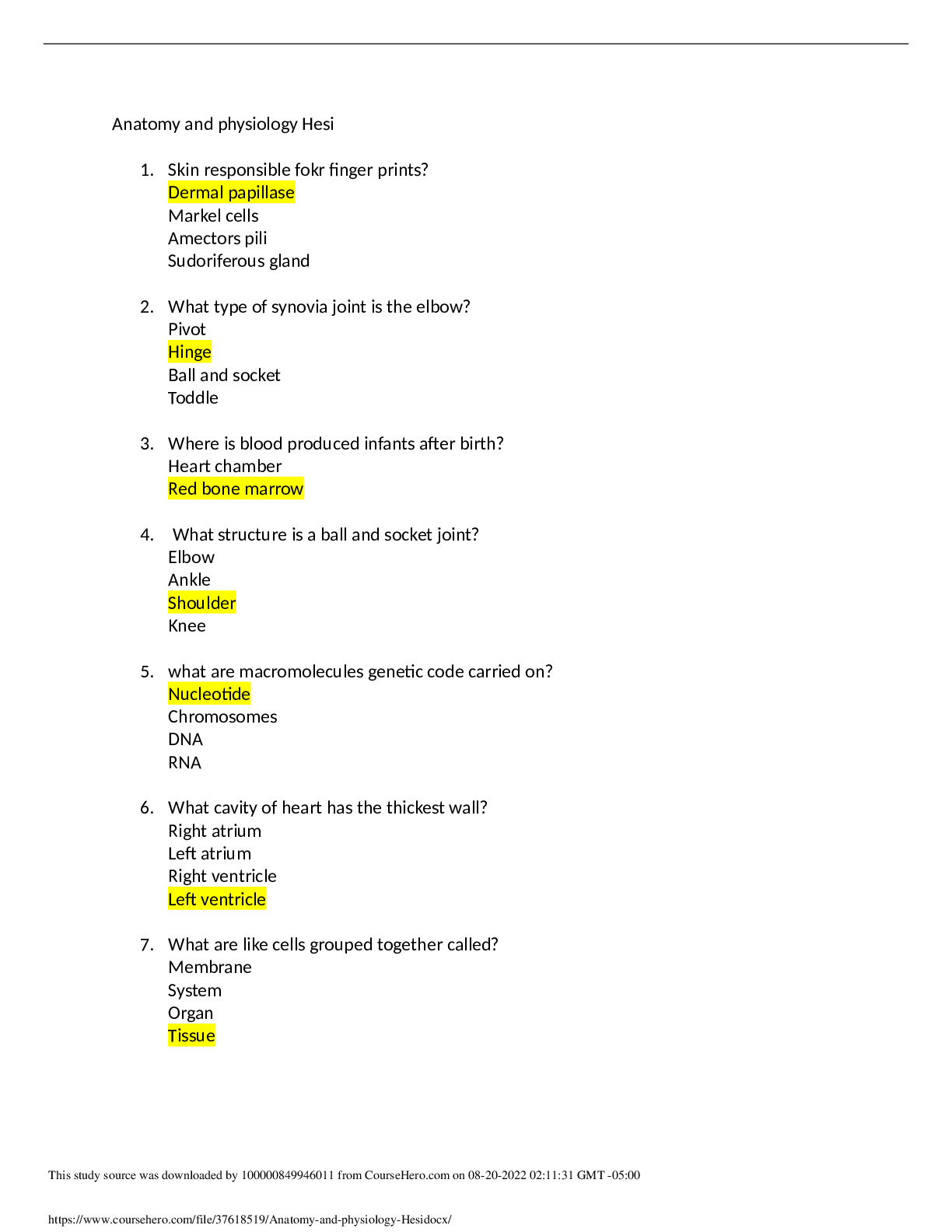
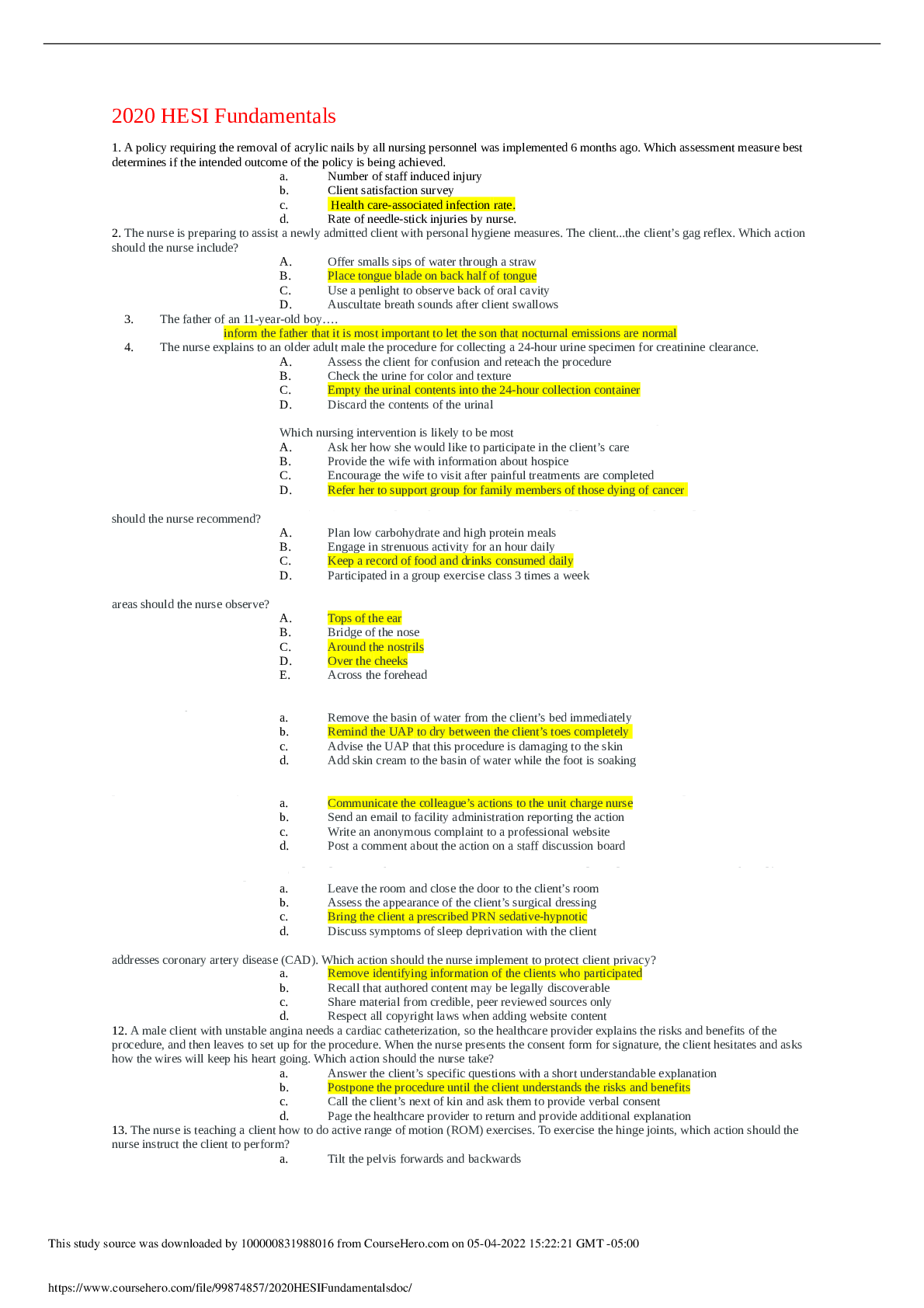

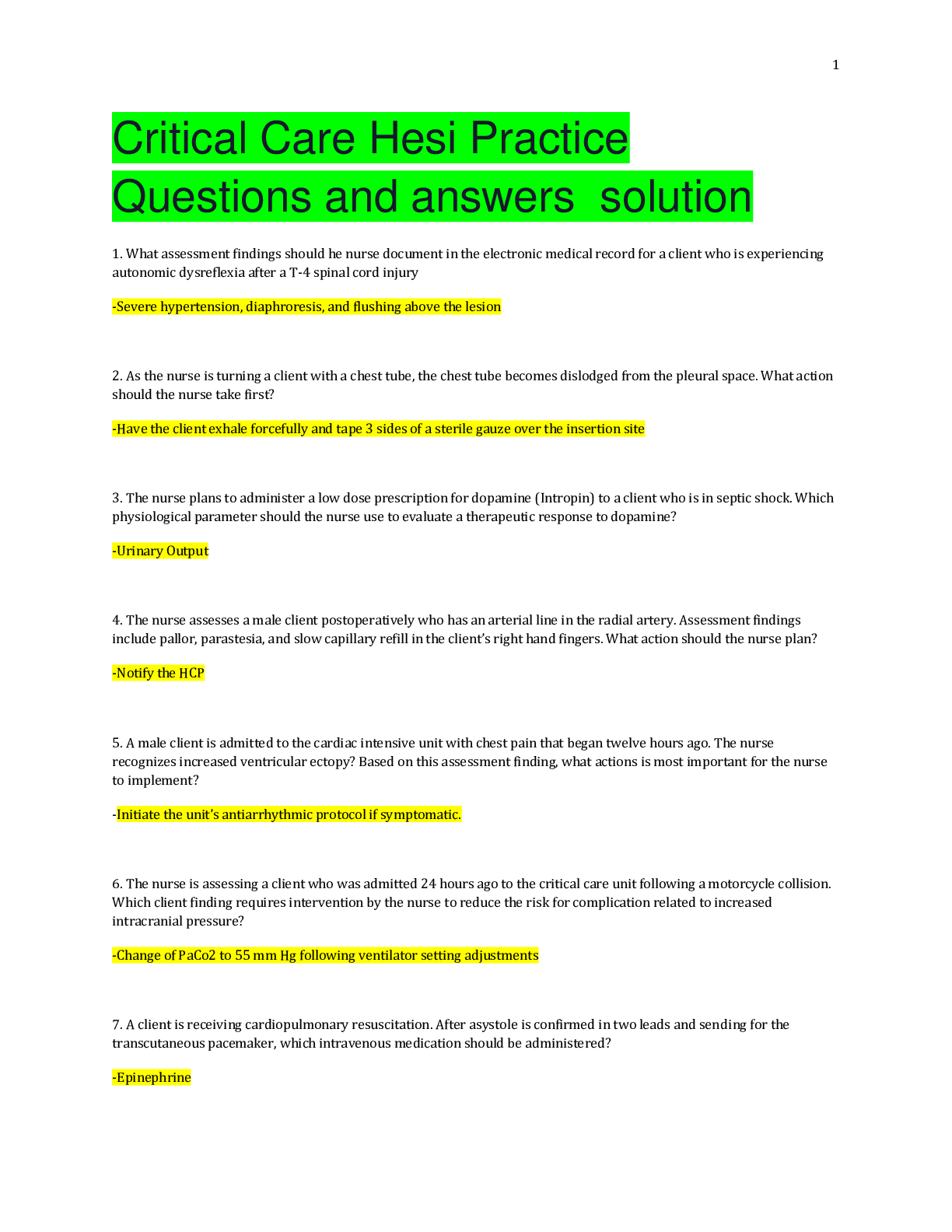
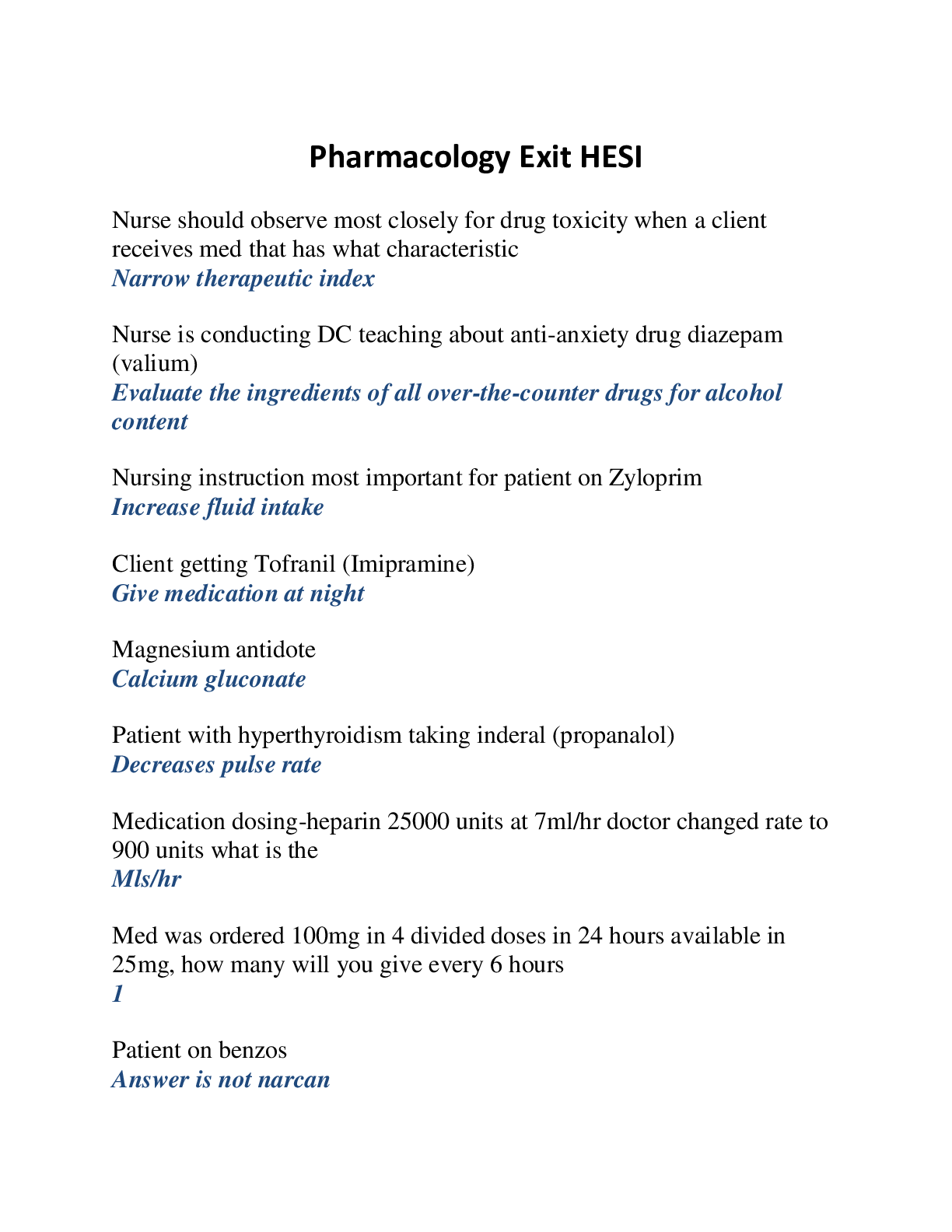
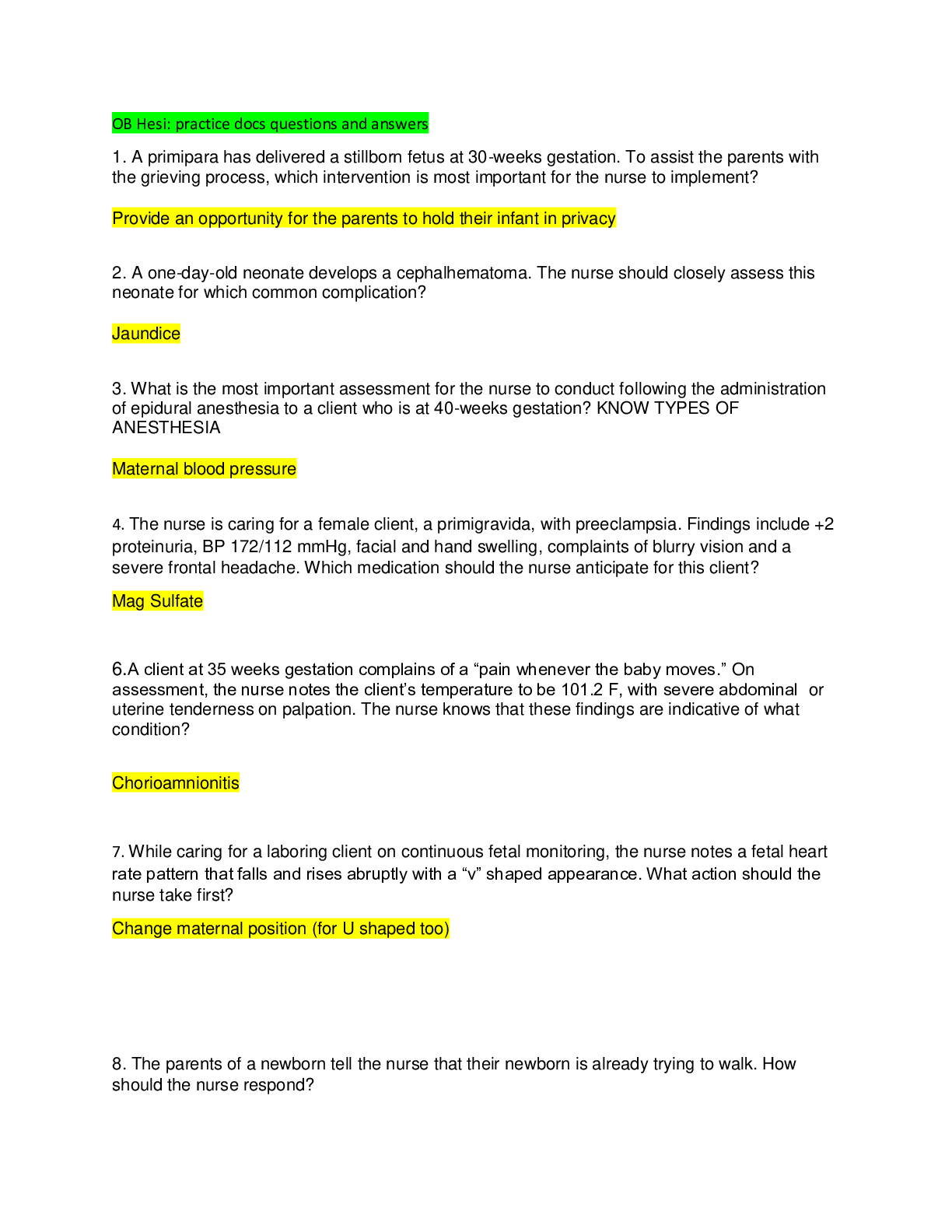


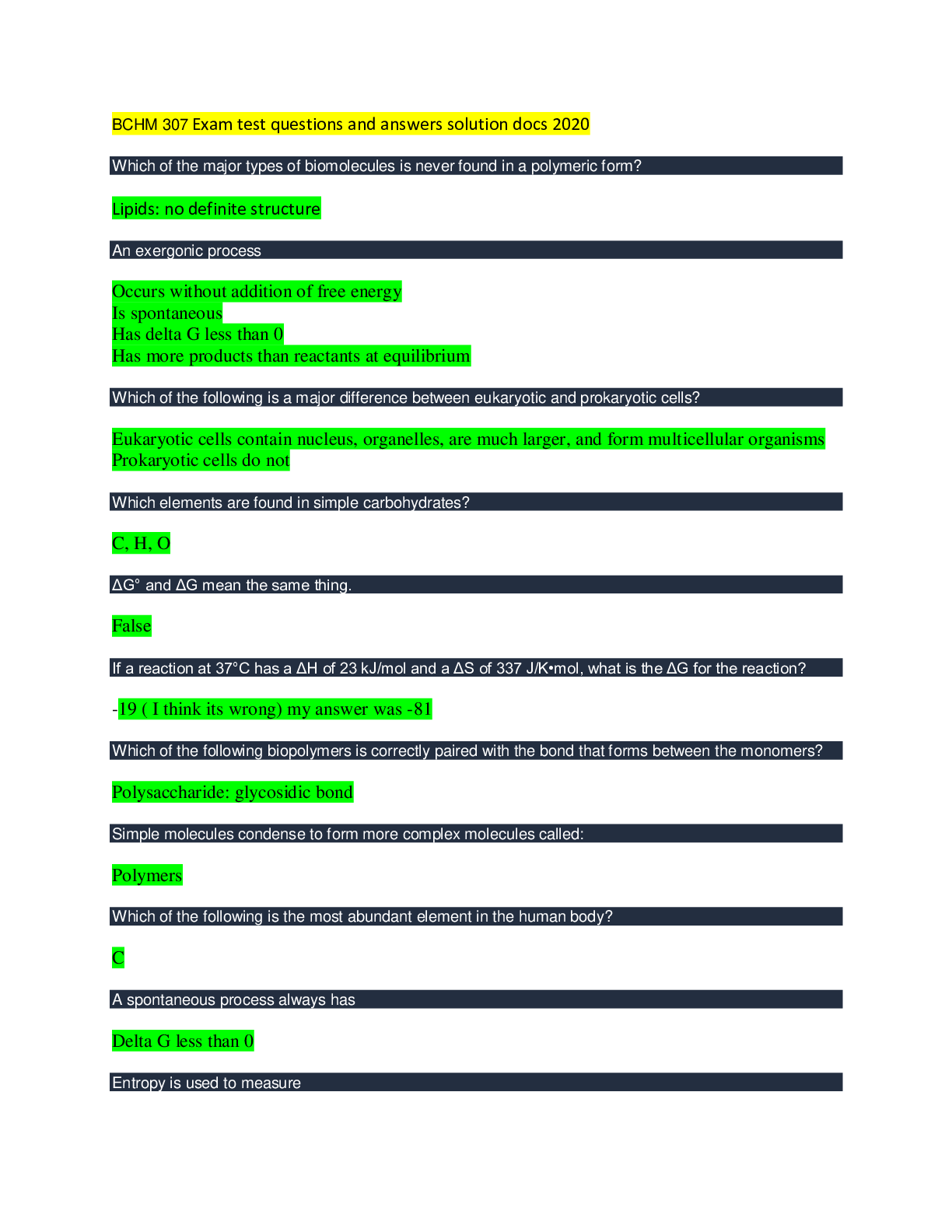
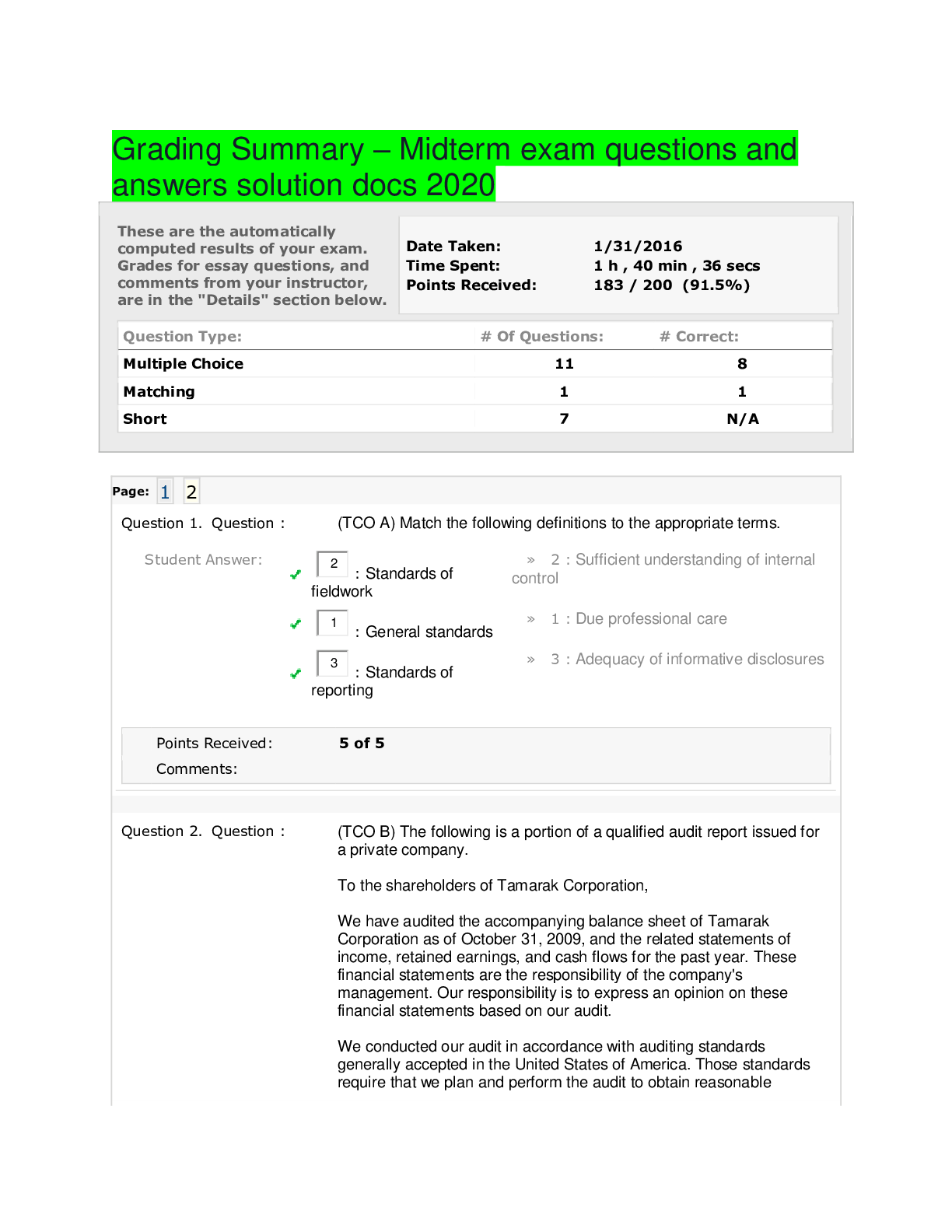
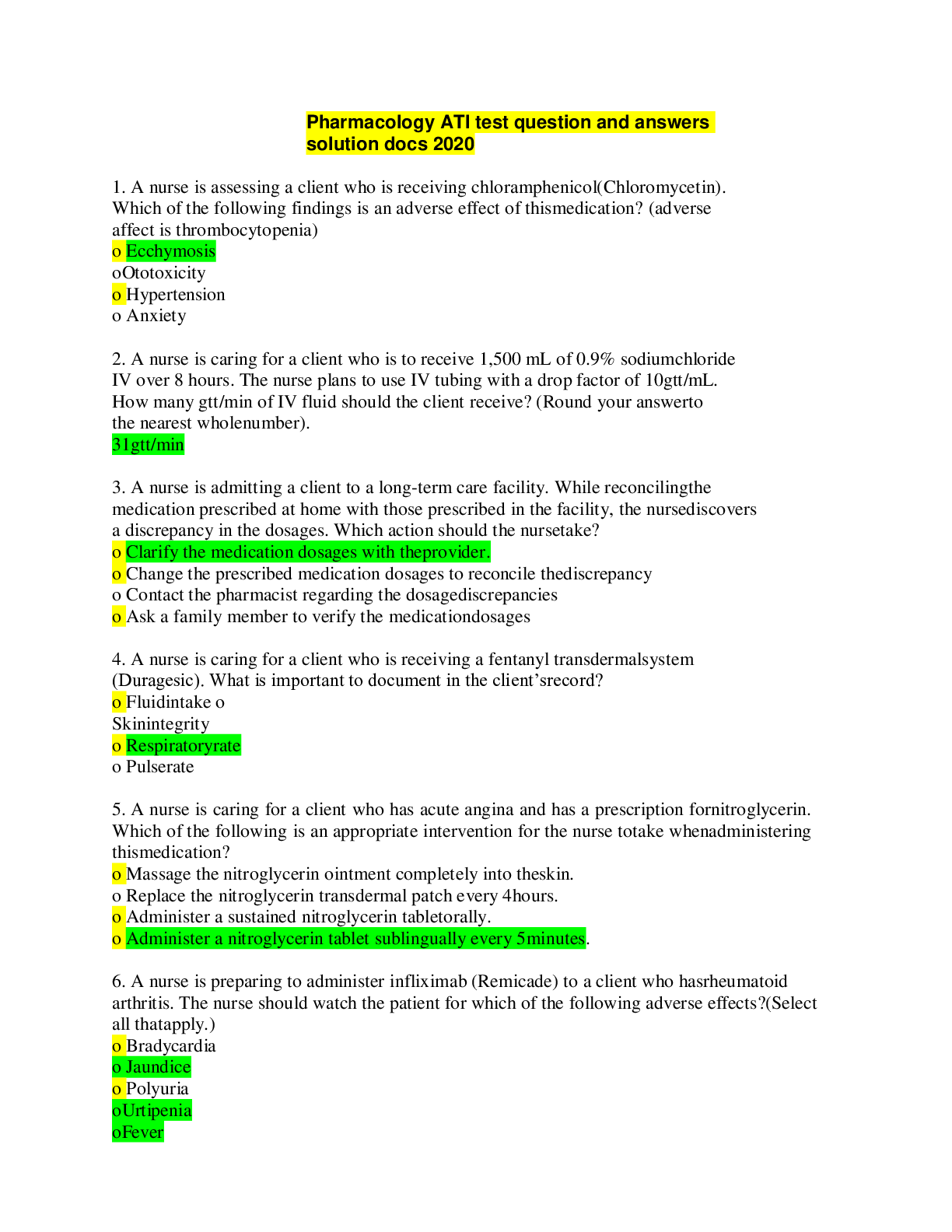

 ans (1).png)

 answers.png)
 ansswers.png)
.png)

